
Overview
Radicular pain occurs when a nerve root is compressed or irritated in the spine. Radicular pain is due to direct compression of the nerve but also due to inflammatory mediators that irritate the nerve. The point of compression can be where the nerve crosses the disc (sub-articular) or where the nerve exits the spine (foraminal). Nerve root irritation usually occurs due to compression by a disc protrusion but can also occur due to bony and sometimes soft tissue encroachment into the spinal canal or exit foramen.
Symptoms and Signs
Radicular pain usually is sharp and lancinating down the leg or arm. Nerve pain is a very unpleasant type of pain. Leg and arm pain is worse than the pain in the back or neck. Pain can be exacerbated with movements and postures that stretch the nerve e.g., sitting, straight leg raise for radicular leg pain and looking down and turning the head for radicular arm pain.
When radicular pain is accompanied by numbness, tingling or weakness it is called radiculopathy.
Radicular pain can be reproduced with clinical physical tests including slump stretch, straight leg raise tests for radicular leg pain and foraminal compression test for radicular arm pain. We will also perform and note lower limb or upper limb neurological evaluation to monitor progression.
Special Investigations
X-rays are of little help to investigate radicular pain. A CT or MRI scan can help to show the level and degree of radicular nerve compression.
Sometimes MRI’s or CT’s show more than one level of potential nerve compression. In these cases, interventions can help to localise the most likely affected level of nerve compression.
Treatment
The good news is that most people with radicular pain recover within a short period of time, with no need for treatment.
Pharmacological measures can be very helpful to manage acute radicular symptoms. These include anti-inflammatory medication to reduce inflammatory mediated nerve irritation and neuroleptic medication (such as Amitriptyline) to reduce nerve irritability.
An epidural injection is an effective treatment to reduce radicular pain symptoms in the acute setting. Studies have shown epidural injections are more effective if performed early in the presentation.
A small number of people with radicular pain will require surgery. Indications for surgery are radicular pain accompanied by persisting radiculopathy (weakness) or persistent pain not responding to conservative measures.
Treatment options for chronic radicular pain are pulsed radiofrequency stimulation to desensitise the irritated nerve root, adhesiolysis for nerve pain due to tethering of the nerve root in the epidural space and electric nerve stimulation (neuromodulation).